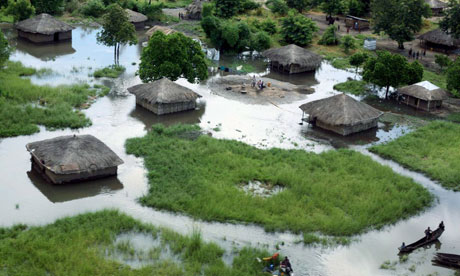| Richard Norgaard, expert en économie
de l'environnement à l'Université de Berkeley (Californie),
a dirigé une étude(1) publiée le 22 janvier
dans Proceedings of the National academy of sciences: elle évalue
les dommages environnementaux engendrés entre 1961 et 2000 par les
pays riches et affectant les pays plus pauvres à travers leur mode
de consommation. D'après un article du Guardian publié
le 21 janvier (voir ci-contre), les auteurs ont estimé que l'impact
équivaut à plus de 1.800 milliards de dollars (1.232 milliards
€), qui est le montant total de la dette des pays du tiers-monde.
Selon eux, les émissions des gaz à effet de serre (GES) issues
des pays à faible revenu auraient par exemple entraîné
740 milliards de dollars (environ 506 milliards €) de dommages chez
les pays à revenu élevé, alors que les pays à
revenu élevé auraient causé 2.300 milliards de dollars
(1.570 milliards €) de dommages chez les pays à faible revenu,
tels que des inondations résultant du changement climatique.
L'équipe s'est appuyée pour ses calculs sur des données de la Banque mondiale et de l'évaluation des écosystèmes pour le Millénaire des Nations Unies, et s'est focalisée sur 6 secteurs: les émissions de GES, la réduction de la couche d'ozone, l'agriculture, la déforestation, la surpêche et la conversion de mangroves en fermes dédiées à l'élevage de crevettes. «Au moins jusqu'à un certain point, les pays riches se sont développés au détriment des pauvres, et il y a effectivement une dette envers les pauvres», a déclaré Richard Norgaard. (1) The debt of nations and the distribution of ecological impacts from human activities, Proc. Natl. Acad. Sci. USA, voir ci-dessous. http://www.pnas.org/ SUSTAINABILITY SCIENCE The debt of nations and the distribution of ecological impacts from human activities U. Thara Srinivasana,b, Susan P. Careyc, Eric Hallsteind, Paul A. T. Higginsd,e, Amber C. Kerrd, Laura E. Koteend, Adam B. Smithd, Reg Watsonf, John Hartec,d, and Richard B. Norgaardd aPacific Ecoinformatics and Computational Ecology Laboratory, Berkeley, CA 94703 bTo whom correspondence should be addressed. E-mail: utharas@gmail.com dEnergy and Resources Group, 310 Barrows Hall, University of California, Berkeley, CA 94720-3050 cDepartment of Environmental Science, Policy, and Management, University of California, Berkeley, CA 94720-3114 eAmerican Meteorological Society, 1120 G Street NW, Washington, DC 20005-3826 fSea Around Us Project, Fisheries Centre, University of British Columbia, Vancouver, BC, Canada V6T 1Z4 Communicated by Kirk R. Smith, University of California, Berkeley, CA, October 19, 2007 (received for review February 3, 2007) Abstract As human impacts to the environment accelerate, disparities in the distribution of damages between rich and poor nations mount. Globally, environmental change is dramatically affecting the flow of ecosystem services, but the distribution of ecological damages and their driving forces has not been estimated. Here, we conservatively estimate the environmental costs of human activities over 1961–2000 in six major categories (climate change, stratospheric ozone depletion, agricultural intensification and expansion, deforestation, overfishing, and mangrove conversion), quantitatively connecting costs borne by poor, middle-income, and rich nations to specific activities by each of these groups. Adjusting impact valuations for different standards of living across the groups as commonly practiced, we find striking imbalances. Climate change and ozone depletion impacts predicted for low-income nations have been overwhelmingly driven by emissions from the other two groups, a pattern also observed for overfishing damages indirectly driven by the consumption of fishery products. Indeed, through disproportionate emissions of greenhouse gases alone, the rich group may have imposed climate damages on the poor group greater than the latter's current foreign debt. Our analysis provides prima facie evidence for an uneven distribution pattern of damages across income groups. Moreover, our estimates of each group's share in various damaging activities are independent from controversies in environmental valuation methods. In a world increasingly connected ecologically and economically, our analysis is thus an early step toward reframing issues of environmental responsibility, development, and globalization in accordance with ecological costs. ecological degradation | ecosystem change | ecosystem services | external cost Footnotes Author contributions: U.T.S. and J.H. designed research; U.T.S., S.P.C., A.C.K., A.B.S., and R.W. performed research; U.T.S., S.P.C., E.H., P.A.T.H., A.C.K., L.E.K., A.B.S., and R.W. analyzed data; and U.T.S. and R.B.N. wrote the paper. The authors declare no conflict of interest. |
http://www.guardian.co.uk/science/2008/jan/21/environmental.debt1
Rich countries owe poor a huge environmental debt This article was first published on guardian.co.uk on Monday January 21 2008. It was last updated at 02:37 on January 22 2008. The study found that there are huge disparities in the ecological footprint inflicted by rich and poor countries on the rest of the world because of differences in consumption. The authors say that the west's high living standards are maintained in part through the huge unrecognised ecological debts it has built up with developing countries. "At least to some extent, the rich nations have developed at the expense of the poor and, in effect, there is a debt to the poor," said Prof Richard Norgaard, an ecological economist at the University of California, Berkeley, who led the study. "That, perhaps, is one reason that they are poor. You don't see it until you do the kind of accounting that we do here." Using data from the World Bank and the UN's Millennium Ecosystem Assessment, the researchers examined so-called "environmental externalities" or costs that are not included in the prices paid for goods but which cover ecological damage linked to their consumption. They focused on six areas: greenhouse gas emissions, ozone layer depletion, agriculture, deforestation, overfishing and converting mangrove swamps into shrimp farms. The team calculated the costs of consumption in low, medium and high income countries, both within their borders and outside, from 1961 to 2000. The team used UN definitions for countries in different income categories. Low income countries included Pakistan, Nigeria and Vietnam, and middle income nations included Brazil and China. Rich countries in the study included the UK, US and Japan. Striking disparities
|
